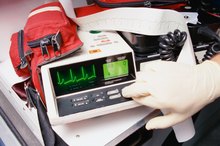What Are the Causes of Pain, Numbness & Tingling in the Left Arm?
The person walking into an emergency room with symptoms of pain, numbness and tingling in the left arm should be prepared for a series of tests to rule out a heart problem. This is not because a heart problem is the most common cause of these symptoms, but because it is the most serious of the possible causes, and the one that demands immediate medical treatment. Problems originating in the neck, shoulder or peripheral nerves can also cause these symptoms.
If you are experiencing serious medical symptoms, seek emergency treatment immediately.
Numerous conditions can cause pain, numbness and tingling in the left arm. According to the National Institute of Arthritis and Musculoskeletal and Skin Diseases, or NIAMS, pain, numbness and tingling in the left shoulder and arm may indicate a myocardial infarction, or heart attack.
However, other conditions may be more likely to cause left-sided arm pain, numbness and tingling. In most cases, conditions causing these symptoms are not a medical emergency and respond well to conservative care methods.
Thoracic Outlet Syndrome
Thoracic outlet syndrome is a musculoskeletal condition that can cause pain, numbness and tingling in the left arm.
According to the National Institute of Neurological Disorders and Stroke, or NINDS, thoracic outlet syndrome is caused by the compression of nerves or blood vessels as they course through the narrow passageway leading from the lower neck to the axilla or armpit.
The Mayo Clinic states that possible causes of thoracic outlet syndrome include:
- anatomical defects such as a cervical rib
- poor posture
- traumatic injuries
- repetitive activity
- obesity
- increased joint pressure
- pregnancy
Cervical Disc Herniation
Causes of Pain on the Right Side of the Neck Down to the Shoulder
Learn More
A cervical disc herniation can compress nerve roots in the neck and cause pain, numbness and tingling in the left arm.
The Mayfield Clinic--one of the world's largest neurosurgical practices--states that a cervical disc herniation is a spine condition in which the center of a spinal disc--the nucleus pulposus--ruptures through a weak spot in the disc's fibrous outer ring.
In some cases, the herniated disc material protrudes into the spinal column or the hole through which the spinal nerve roots-- offshoots of the spinal cord--exit the spinal column, compressing or irritating the nerve roots and causing arm pain, numbness and tingling on one side of the body.
Cervical disc herniation symptoms largely depend on the specific disc that ruptures, although common signs and symptoms include:
- pain that radiates down the neck and arm and into the hand
- arm numbness and tingling
- muscles spasms
- arm muscle weakness
- decreased grip strength
- A cervical disc herniation can compress nerve roots in the neck and cause pain, numbness and tingling in the left arm.
- In some cases, the herniated disc material protrudes into the spinal column or the hole through which the spinal nerve roots-- offshoots of the spinal cord--exit the spinal column, compressing or irritating the nerve roots and causing arm pain, numbness and tingling on one side of the body.
Brachial Plexus Injuries
Brachial plexus injuries involve nerve damage that can cause pain, numbness and tingling in the left arm.
The most common cause of brachial plexus injuries is an over-stretching of the neck.
In most cases, the head and neck are violently forced away from the affected shoulder while the shoulder is depressed or forced downward. Motorcycle accidents and contact sports injuries are common sources of brachial plexus injuries.
Possible signs and symptoms associated with brachial plexus injuries include:
- an electrical shock-like sensation down the arm
- numbness and tingling in the arm
- in more severe cases, the inability to use the arm or fingers
- Brachial plexus injuries involve nerve damage that can cause pain, numbness and tingling in the left arm.
Related Articles
References
- National Institute of Neurological Disorders and Stroke: What is Thoracic Outlet Syndrome?
- Mayfield Clinic: Herniated Cervical Disc
- American Society for Surgery of the Hand: Brachial Plexus
- MayoClinic: Thoracic Outlet Syndrome
- Klein JP. Imaging of progressive weakness or numbness of central or peripheral origin. Handb Clin Neurol. 2016;136:923-37. doi:10.1016/B978-0-444-53486-6.00047-8
- Bracker MD, Ralph LP. The numb arm and hand. Am Fam Physician. 1995;51(1):103-16.
- Wipperman J, Goerl K. Carpal Tunnel Syndrome: Diagnosis and Management. Am Fam Physician. 2016;94(12):993-999.
- Mellion M, Gilchrist JM, De La Monte S. Alcohol-related peripheral neuropathy: nutritional, toxic, or both? Muscle Nerve. 2011;43(3):309-16. doi:10.1002/mus.21946
- Cohen KR, Salbu RL, Frank J, Israel I. Presentation and management of herpes zoster (shingles) in the geriatric population. P T. 2013;38(4):217-27.
- Halperin JJ. Chronic Lyme disease: misconceptions and challenges for patient management. Infect Drug Resist. 2015;8:119-28. doi:10.2147/IDR.S66739
- Okazaki T, Shinagawa S, Mikage H. Vasculitis syndrome-diagnosis and therapy. J Gen Fam Med. 2017;18(2):72-78. doi:10.1002/jgf2.4
- Saint-lary O, Rébois A, Mediouni Z, Descatha A. Carpal tunnel syndrome: primary care and occupational factors. Front Med (Lausanne). 2015;2:28. doi:10.3389/fmed.2015.00028
- England JD, Gronseth GS, Franklin G, et al. Evaluation of Distal Symmetric Polyneuropathy: the Role of Laboratory and Genetic Testing (an Evidence-Based Review). Muscle Nerve 2009; 39:116.
- Gilman, S, Newman, SW. Manter and Gatz's Essentials of Clinical Neuroanatomy and Neurophysiology, 8, FA Davis, Philadelphia 1992.
- Patten J. Neurological Differential Diagnosis, 2nd, Springer, New York 1996.
Writer Bio
Martin Hughes is a chiropractic physician, health writer and the co-owner of a website devoted to natural footgear. He writes about health, fitness, diet and lifestyle. Hughes earned his Bachelor of Science in kinesiology at the University of Waterloo and his doctoral degree from Western States Chiropractic College in Portland, Ore.







